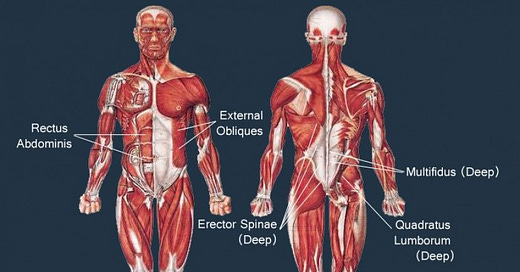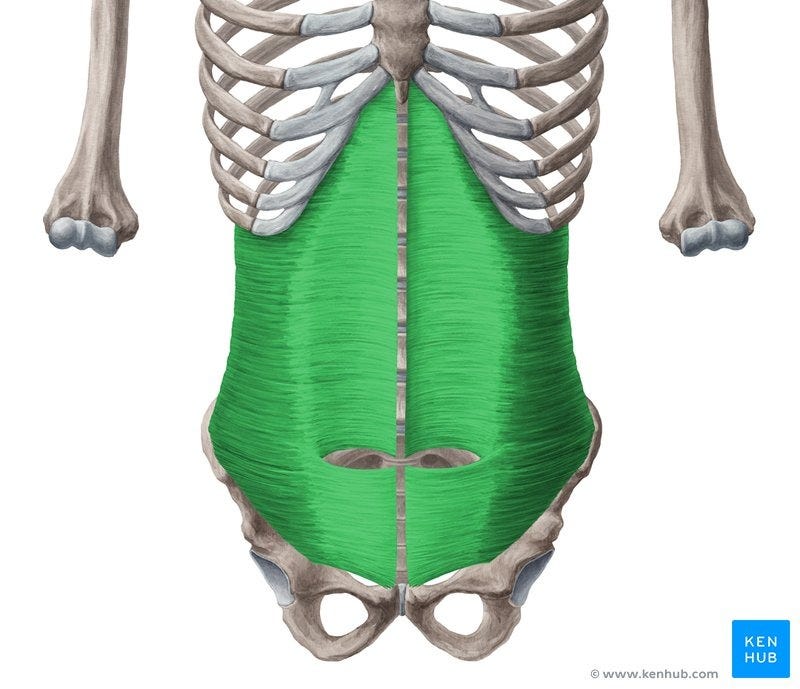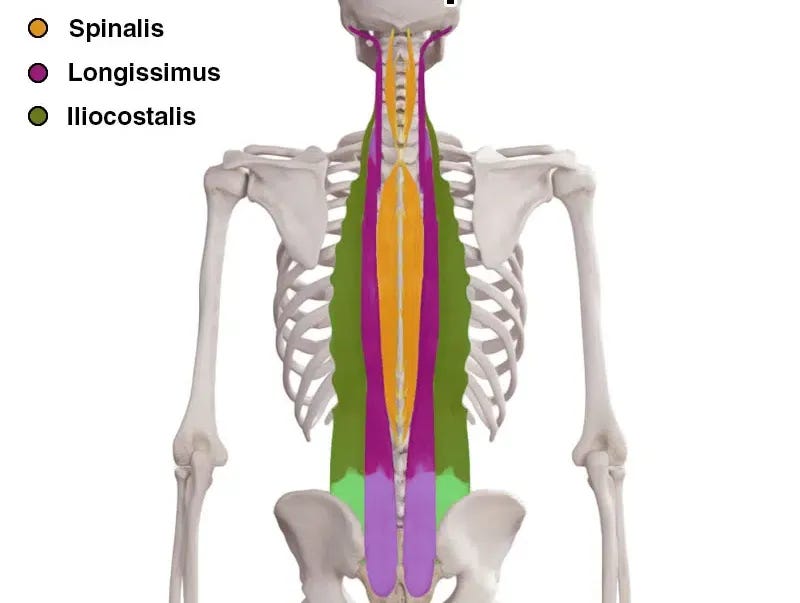Happy Monday! Let’s get it off to a good start by taking a deep dive into all things trunk-related. As you’ll recall, our Muscle Monday series has now started exploring the muscles above the waist. Last week, we had a look at the muscles around the chest. If you haven’t had a chance to catch it yet, I have inserted the link just below.
Thank you’s, links, and affiliates
The ridiculous growth of this platform continues. I will continue to thank you all for your efforts, because the audience is growing at an exponential rate. I ended 2024 on ~50 subscribers, and it looks as though we will have hit 500 by the time this article goes out. Please keep sharing and spreading the word, it means a lot! As usual, hit the buttons below to follow my Instagram account, refer a friend, or subscribe.
We also now have an official affiliate. If you want a 10% discount on your next Awesome Supplements order, hit this link and enter ‘EZEP’ at checkout!
Muscles of the trunk
First up, just to clarify, the words ‘trunk’ and ‘core’ are often used interchangeably. My personal preference is to use trunk, simply because ‘core’ seems to be a bit of a buzzword. I could also use ‘abdomen’, but I feel most people immediately then forget the muscles around the back, and focus on the ‘abs’, if this is used. Moving forward, the word ‘trunk’ will refer to the muscles in the midsection of the body: front, side, and back, from the chest to the waist. Therefore, there may be a small overlap when we get to the focus on the back muscles later in the series. I have cherry-picked 5 muscles for us to look at here, but this is by absolutely no means an exhaustive list; simply 5 I believe deserve more attention and focus.
The Transversus abdominis is the deepest of the muscles in the trunk. It wraps completely around the body, with the muscle fibres running horizontally, almost like a large, long cummerbund or corset, tightening the area. It isn’t represented in the image above, so I have inserted a separate picture of the muscle below this paragraph.
The Rectus abdominis is probably the star of the trunk area. In fact, it is probably the reason you’re reading this article. If you want a ‘6-pack’ this is the muscle you’re interested in. It sits on top of the transversus abdominis, as a narrow strip. Technically, this strip is two parallel muscles, running length-wise down the torso, separated by a vertical piece of connective tissue known as the linea alba. These halves are then further divided by three ‘tendinous intersections’ which run horizontally across the torso, to give it that familiar ‘6-pack’ look. Sadly, any subcutaneous fat which suits around the front of the torso can make it hard to see this muscle, which is why a low body fat content is one way to ensure a visible 6-pack.
The External obliques are the muscles in your sides. Again, they are large and long, reaching from the lower ribs to the pelvis. They are superficial, meaning that they sit just below the skin. However, a separate muscle group, called the internal obliques, sits below the external obliques, in a deeper position. The fibres here run in a path akin to putting your hands towards your pockets, so downward and inward.
If we spin ourselves around, the Erector spinae muscles are a set of muscles which run vertically down our back. There are technically nine erector spinae muscles (3 sets of 3 muscles). To make life easier, again, I have inserted an image below. In this image, there are three of each colour of muscle (3 spinalis, 3 longissimus, and 3 iliocostalis).
The Quadratus lumborum (QL) is a pair of muscles that sit very deep in the lower back, either side of the spine. They actually run from the transverse processes of the lumbar spine (those parts of the vertebrae which jut out to the side), through to the iliac crest of the pelvis.
Function of the trunk muscles
The muscles around the trunk have some unique, and some overlapping functions. Let’s take a look.
The transversus abdominis
This muscle is a little bit different. Whilst most muscles’ primary purpose is to act on bones to cause movement around a joint, the transversus abdominis primarily exists to keep your organs where they need to be. It is responsible for maintaining correct tension and posture and is involved in actions where pressure changes, such as during sneezing and coughing. Of course, it does also play a role in supporting and stabilising the lower back.
The rectus abdominis
The rectus abdominis muscle is primarily involved in an action known as trunk flexion. This is the act of compressing the abdomen by leaning forward. For example, this can be achieved by performing a sit-up, taking some recovery breaths and placing your hands on your knees, or reaching down to touch your toes whilst standing.
The external obliques
Since these are located on the side of the trunk, the obliques are more responsible for rotation and lateral movements than the other trunk muscles.
For example, the external obliques assist in trunk rotation (literally rotating the torso), and trunk lateral flexion (think sliding one hand down the side of your leg until you feel a stretch on the opposite side of the abdomen). They can also assist the other trunk muscles to achieve trunk flexion.
The erector spinae
Since there are 9 muscles that run down the length of the torso, the function of the erector spinae muscles can vary greatly depending on location. I won’t go into the details of each muscle separately in this piece.
As a whole, they are responsible for torso and trunk stabilisation, and correct posture. This may be during standing, locomotion, or sitting. They also aid with:
Back and head extension (think lying prone, then lifting your head and chest off the floor).
Head rotation
Lateral trunk flexion
Trunk rotation
The quadratus lumborum
The QL muscles can help support the diaphragm and surrounding tissues during breathing, specifically inspiration, or breathing in.
Due to its position in the lower (lumbar) region, it is traditionally thought to aid with the extension of the lower back, however, the degree to which it contributes to this movement is currently unclear. It may also assist with lateral flexion.
Unique conditions (Besides strains and tears)
There are a few common, but unique conditions that occur within the trunk. I am not going to cover conditions of the spine and associated posture-related conditions in this article (lordosis, scoliosis etc), as this will be explained in future work.
Diastasis Recti
This condition occurs when the rectus abdominis muscles separate from the linea alba. Remember, this is the line of connective tissue located down the muscle's midline. There are a few potential causes of this condition, such as very rapid weight gain, or gym-related injury, but by far the most common cause is pregnancy. When pregnant, the growing womb can put a strain on the rectus abdominis and push these muscles apart from the linea alba. For most women, this separation heals within 8 weeks post-partum.
Hernia
Earlier in this piece, we spoke about how the transversus abdominis helps to keep the internal organs where they belong. However, the muscles can’t always keep up. A hernia occurs when a part of an internal organ pushes through the surrounding muscles and/or tissues, potentially causing a palpable lump. They can occur in a variety of locations on the body, including the groin (inguinal or femoral), near the belly button (umbilical), and upper stomach region (hiatal).
Whilst they have multiple possible causes, most often they appear due to intense or repeated strain such as coughing or sneezing, excessive exercise and/or improper technique, and age-related muscle weakening.
In the majority of cases, they can be surgically repaired, but occasionally may be monitored without surgery.
Lower back pain
This is a huge umbrella term for - you guessed it - pain in the lower back region. It affects millions of individuals around the world, of all ages, activity levels, and health statuses.
The modern lifestyle of increased sedentary time, poor posture, limited physical activity and increased obesity rates all feed into the development of lower back pain. Without going into too much detail, in many individuals, this pain is likely caused by a weakness or tightness of certain muscles, including, but not limited to, the quadratus lumborum, erector spinae, multifidus, glutes, and hip flexors.
Strengthening the trunk muscles
If we rewind to the major actions of the muscles in the trunk, we can observe some overlapping movements: trunk flexion, back extension, lateral trunk flexion and trunk rotation. Many of the exercises which replicate these movements, under correct load and progression, will lead to a strengthening of the muscles we have looked at today. For example:
Sit ups
V-Ups
Most crunch varieties
Will improve the strength of the muscles responsible for trunk flexion, such as the rectus abdominis.
Side planks
Kettlebell around the world
Russian twists
Cable woodchoppers
Weighted side bends
Will work on the muscles responsible for rotation and lateral flexion, such as the obliques.
Supermans
Bird dogs
Cobra pose
Cable rotation
Any posterior chain hinge (deadlift/good morning)
Will aid with the development of the erector spinae and quadratus lumborum muscles, which protect the spine and help with back extension.
Thank you once more for taking the time to read my work. I love to write these pieces and appreciate any feedback you may have. Please do share with anyone who may be interested by hitting the button below. See you next Monday!







